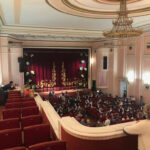Francisco Iturrino, a Spanish artist born in Santander, navigated the currents of post-Impressionism and Fauvism to forge a distinctive style. His painting, “Nudes (Women Dancing in a Ring)”, created circa 1916-1918, stands as a compelling example of his unique approach to the female form and his vibrant use of color. Acquired in 1926, this oil on canvas work, measuring 140.5 x 172.8 cm, showcases Iturrino’s departure from traditional perspective and his embrace of expressive, luminous settings.
Iturrino’s artistic journey, though encompassing landscapes, portraits, and animal paintings, is particularly marked by his exploration of groups of women, both clothed and nude. In “Nudes (Women Dancing in a Ring)”, this focus is powerfully evident. The painting boldly rejects conventional perspective, bringing the female figures to the forefront. These are not delicate or idealized nudes; instead, Iturrino presents robust, almost sculptural bodies, defined by strong outlines and modeled with rich, chromatic shades. The space within the painting is constructed entirely by the arrangement of these figures, emphasizing their physicality and presence. This technique aligns with post-Impressionist principles, where emotional expression and subjective experience often took precedence over realistic representation.
Born in 1864, Iturrino’s training in Brussels and Paris exposed him to Symbolism and Impressionism, and he briefly aligned himself with the aesthetics of “Black Spain.” He achieved early recognition in France, exhibiting regularly and even holding a solo exhibition at the Salon d’Automne in 1911. However, a pivotal moment in his artistic development was his first visit to Andalusia in 1901. The Andalusian landscape and light profoundly influenced him, solidifying his personal style. His circle of friends included prominent artists such as Renoir, Derain, Picasso, and notably Matisse, with whom he traveled through southern Spain in 1910 and Morocco in 1912. The influence of Matisse, along with that of Cézanne, is discernible in Iturrino’s mature works. Similar to Fauvist practices, Iturrino’s treatment of light and color in “Nudes (Women Dancing in a Ring)” is characterized by its boldness and expressive nature, moving away from purely representational aims towards a more subjective and emotional use of these elements.
“Nudes (Women Dancing in a Ring)” is more than just a depiction of nude women; it is an exploration of form and color, imbued with a sense of dynamism and vitality. The painting captures a moment of joyful movement, the women’s dance suggesting freedom and a celebration of the body. Iturrino’s work, while rooted in post-Impressionism, pushes towards a more Fauvist sensibility through its heightened color palette and simplified forms. This painting remains a significant piece within Iturrino’s oeuvre, highlighting his innovative approach to depicting the human figure and his contribution to early 20th-century European painting.
Selected Bibliography
- Castañer López, Xesqui. “Iconografía de la mujer en los pintores vascos, siglos XIX y XX”, Kobie : bellas artes, n° 2. 1984. p. 107.
- Pintura española del siglo XX [Cat. exp.]. Madrid, Ministerio de Cultura, 1978.
- Bengoechea, Javier de. Catálogo de arte moderno y contemporáneo del Museo de Bellas Artes de Bilbao. Bilbao, Banco de Vizcaya, 1980. p. 69. (Con el título Desnudos).
- Barañano, Kosme María de ; González de Durana, Javier. Francisco Iturrinoren grafizko artelaren bilduma-liburua = Catálogo de la obra gráfica de Francisco Iturrino. Vitoria-Gasteiz, Eusko Jaurlaritza = Gobierno Vasco, 1988. p. 23, il.
- Nosotros los vascos : arte IV : del neoclasicismo a las tendencias modernas del arte. Donostia-San Sebastián, Lur, 1989. p. 190.
- La pintura del siglo XX en Cantabria : tradición y vanguardia [Cat. exp.]. Santander, Museo de Bellas Artes, 1991. p. 44
- Joos, Petra. Francisco Iturrino, 1864-1924 [Cat. exp.]. Madrid, Fundación Mapfre, 1996. pp. 182-183.
- Joos, Petra. Francisco Iturrino, 1864-1924 [Cat. exp.]. Donostia-San Sebastián, Fondación Social y Cultural Kutxa, 1996. p. 65.
- Museo de Bellas Artes de Bilbao : guía. Bilbao, Bilboko Arte Ederren Museoa-Museo de Bellas Artes de Bilbao, 2006. pp. 124-125.
- Musée des Beaux Arts de Bilbao : guide. Bilbao, Bilboko Arte Ederren Museoa-Museo de Bellas Artes de Bilbao, 2006. pp. 124-125.
- Bilbao Fine Arts Museum : guide. Bilbao, Bilboko Arte Ederren Museoa-Museo de Bellas Artes de Bilbao, 2006. pp. 124-125.
- Manterola Ispizua, Ismael. Hermes y los pintores vascos de su tiempo. Bilbao, Bizkaiko Foru Aldundia = Diputación Foral de Bizkaia, 2006. pp. 224-225
- Guía Artistas Vascos. Bilbao, Museo de Bellas Artes de Bilbao, 2008. pp. 46-48.
- Gida Euskal Artistak. Bilbao, Bilboko Arte Eder Museoa, 2008. pp. 46, 48.
- Museo de Bellas Artes de Bilbao : guía. Bilbao, Bilboko Arte Ederren Museoa-Museo de Bellas Artes de Bilbao, 2011. pp. 124-125, n° cat. 85b.
- Bilboko Arte Ederren Museoa : gida. Bilbao, Bilboko Arte Ederren Museoa-Museo de Bellas Artes de Bilbao, 2012. pp. 124-125, n° cat. 85b.
- Guide Basque Artists. Bilbao, Bilbao Fine Arts Museum, 2012. pp. 46-47, n° cat. 21c.
- Bilbao Fine Arts Museum : guide. Bilbao, Bilboko Arte Ederren Museoa-Museo de Bellas Artes de Bilbao, 2014. pp. 124-125.
- Musée des Beaux Arts de Bilbao : guide. Bilbao, Bilboko Arte Ederren Museoa-Museo de Bellas Artes de Bilbao, 2014. pp. 124-125.
- La furia del color : Francisco Iturrrino, 1864-1924 [Cat. exp.]. Málaga, Fundación Palacio Villalón, 2018. pp. 32, 164-165, n° cat. 55.


